Instituto de Astronomía Teórica y Experimental
| Instituto de Astronomía Teórica y Experimental | |
|---|---|
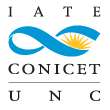 | |
| Acronym | IATE |
| Established | 2006 |
| Director | Dr. Diego García Lambas |
| DIC | Dra. Andrea Costa |
| Address | Laprida 922 |
| City | Córdoba |
| State | Provincia de Córdoba |
| Country | Argentina |
| Coordinates | 31°25′16″S 64°11′59″W / 31.42111°S 64.19972°W |
| Web Site | http://www.iate.oac.uncor.edu/ |
| [email protected] | |
The Instituto de Astronomía Teórica y Experimental (IATE) is a scientific institute funded by the Consejo Nacional de Investigaciones en Científicas y Técnicas (CONICET) and the Universidad Nacional de Córdoba (UNC), located in the city of Córdoba, Argentina, and dedicated to the study of different topics in astronomy. The headquarters of the institute are located at the Observatorio Astronómico de Córdoba.
History
In the 1960s, Dr. José Luis Sérsic[1] (argentinian scientist mainly known for his empirical law for the intensity of a galaxy called Sersic's Law) created the extragalactic astronomy department at the Observatorio Astronómico de Córdoba, where he developed his academic and research activities, forming his first disciples. In 1983, the department became the "Programa de Investigaciones en Astronomía Teórica y Experimental" (IATE), funded by CONICET, under Dr. Sérsic direction. Following the death of Dr. Sérsic on July 19, 1993, the program was discontinued. However, those graduates and PhD who were trained under his tutelage were ordered to continue with the group IATE as research group within the Observatorio Astronómico, under the leadership of Dr. Diego Garcia Lambas, one of the main disciples of Dr. Sérsic. After more than 10 years of hard work forming graduates, PhD and researchers, and to become one of the most numerous research groups within the Observatorio Astronómico, the IATE group has become one of the institutes of CONICET in 2006, with Dr. Diego Garcia Lambas being its first director. The institute then took the name of Instituto de Astronomía Teórica y Experimental, retaining the acronym IATE.

Members
At the IATE, there are 25 Ph.D in the researcher career of CONICET, 37 Ph.D and postdoctoral fellows, 9 members of the support staff career of CONICET, 1 contract staff, and 2 graduates and Ph.D working at the institute.[2]
| Abadi, Mario | Charalambous, Carolina | Giuppone, Cristian | Muriel, Hernán | Rodríguez, Facundo | Valotto, Carlos |
| Algorry, David | Coenda, Valeria | Gonzalez, Elizabeth | O'Mill, Ana Laura | Rodríguez, Horacio | Vega Neme, Luis |
| Alonso, María Victoria | Colazo, Carlos | Graña, Darío | Oio, Gabriel | Ruíz, Andrés | Vena Valdarenas, Román |
| Baravalle, Laura | Costa, Andrea | Gurovich, Sebastián | Paez Tagliaferro, Tania | Salerno, Juan Manuel | Villalón, Carolina |
| Beaugé, Cristian | Díaz-Giménez, Eugenia | Kanagusuku, María José | Paz, Dante | Sanchez, Bruno | Villarreal, Carolina |
| Benitez Llambay, Alejandro | De los Ríos, Martín | Krapp, Leonardo | Pereyra, Luis | Santucho, Ma. Victoria | Vrech, Rubén |
| Benitez Llambay, Pablo | Domínguez, Mariano | Lares, Marcelo | Ragone Figueroa, Cinthia | Schmidt, Eduardo | Yaryura, Yamila |
| Bertazzi, Viviana | Domínguez, Rubén | Luparello, Heliana | Ramos Almendares, Felipe | Schneiter, Matías | Zandivarez, Ariel |
| Bornancini, Carlos | Donoso Navea, Laura | Maldonado, Victoria | Ramos, Ximena | Sgró, Mario Agustín | Zurbriggen, Ernesto |
| Casagrande, Arnaldo | Donzelli, Carlos | Martínez, Héctor Julián | Recabarren, Pablo | Sieyra, Valeria | |
| Cécere, Mariana | Ferreiro, Diego | Merchán, Manuel | Renzi, Víctor | Sillero Ros, Emanuel | |
| Ceccarelli, Laura | Ferrero, Ismael | Mondino, Anabella | Rodriguez, Adriana | Starck Cuffini, Manuel | |
| Chalela García, Martín | García Lambas, Diego | Muñoz Jofré, María Rosa | Rodriguez, Silvio | Taverna, Antonella | |
Scientific Areas
The lines of research are:
- Galactic and Extragalactic Astronomy
- Large Scale Structure of the Universe
- Planetary Systems
- Astrophysical Plasmas
- Instrumental Astronomy and Site Testing
Galactic and Extragalactic Astronomy
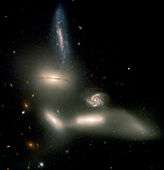
The 13.8 billion years of the Universe is enough time to form giant objects, being the galaxies one of the most interesting. Galaxies are truly island universes where dark matter, billions of stars and huge amounts of gas and dust coexist in equilibrium, and yet, they are an environment suitable for the formation of new stars. Galaxies also tend to cluster in a network of cosmic proportions which highlights fabulous large structures formed by thousands of galaxies. At the IATE, the study of galaxies has been a constant challenge, which has allowed to consolidate over the years different methods for the study of the formation and evolution of galaxies. Some of the most important are:
- Numerical Simulations: the physical processes that govern the evolutionary history of one or many galaxies are recreated by using supercomputers:
- Statistical Studies: properties of galaxies are inferred and analysed from large data surveys;
- Astronomical Observations: classic observations and the most modern and sophisticated techniques are combined by using the telescope facilities around the world.
These and other tools are used by different scientists at the IATE to perform original and reliable astronomical research.
Large Scale Structure of the Universe
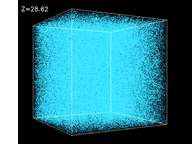
The large-scale structure of the Universe is the field of cosmology that studies the distribution of the matter in the Universe on the largest scales. This field has grown remarkably since the '80s, with the development of three-dimensional maps of galaxies in several bands of the electromagnetic spectrum, and with the observation of the Cosmic Microwave Background (CMB). The increasing flow of information generated by observations has allowed to obtain reliable characterization of the content of the universe comprising
- 74% of vacuum or dark energy,
- 26% dark matter and
- 4% ordinary baryonic matter,
as well as its distribution. The distribution of the structures seems to follow a hierarchical model where the upper level is dominated by a network of clusters and filaments. On top of that, the universe appears to be isotropic and homogeneous in accordance with the cosmological principle. From the analysis of catalogs and the development of numerical simulations, the distribution is characterized through the implementation of different statistics that allow the study of the spatial distribution as well as the dynamics by means of the velocity field of the matter distribution.
Planetary Systems

The question of the existence of other worlds has been present in the history of mankind for centuries, but only recent scientific evidence has confirmed that planets could exist and are common outside the Solar System. Since the first discovery in 1992, over 850 new exoplanets have been cataloged. Contrary to the Solar System, exoplanets' population presents several examples of exoplanets at very small distances from its stars, highly eccentric planetary orbits, and they are frequently found in configurations not previously imagined. This led to the development of new theories and areas of research, which ultimately can help us to better understand the Solar System. Some of the projects that are currently being developed at the IATE include:
- Analyses of observational data for exoplanets (radial velocity and transit);
- Models of tidal interaction with the central star to study the origin of the population of "hot" exoplanets
- Study of the dynamics of extrasolar planets in mean motions resonances;
- Development of hydrodynamic codes to describe the interaction between planets and the protoplanetary disk;
- Analyses of the formation of planets in binary stellar systems.
Astrophysical Plasmas

The plasma is the most common state of the baryonic matter in the Universe (99%). Most of a star, the interplanetary and interstellar medium, and the ionosphere, are plasmas. The plasma can also be generated in terrestrial laboratories for industrial applications such as producing surface coatings, precision cuts in lamps, micro-motors, and plasma reactors. A plasma is a fluid consisting of a large number of free charged particles (globally neutral and whose kinetic energy is larger than the electrostatic potential energy between them). The charges and currents that conform a plasma are sources of the electromagnetic fields and, in turn, these fields affect the distribution of charges and currents which makes its dynamics highly nonlinear and very different from that of a neutral gas. When the magnetic fields are capable of modifying an individual particle trajectory, it is said that the plasma is magnetized. The corona is highly magnetized and therefore, several structures are observed, some of which can maintain its stability for relatively long times as dark filaments on the surface of the sun. In the group of astrophysical plasmas, our scientist perform studies about the dynamic configuration and structures of the corona through the analysis of magnetic arcs and prominences, the formation of voids that remain in the plasma due to the interaction of nonlinear waves, the formation of very energetic shock wave capable of sweeping the chromosphere along a whole quadrant, etc. The team also analyse the interaction of stellar winds with the magnetosphere of exoplanets, and they model the morphology of supernova remnants affected by instabilities and the influence of the magnetic field.
Site Testing
The IATE also performs site testing for the installation of large astronomical facilities in the Argentinian territory. During the 90's (1989-1998), the IATE began the first work on astronomical site testing performing seeing measurements in the Antarctic Base Belgrano II. In 1998, measurements of seeing were performed in the Llano de Chajnantor, Atacama (Chile), as part of a project aimed at installing a liquid mercury telescope in Toco volcano. This project was not successful but the group learnt the use of the most modern technologies for measuring sky parameters. Through this experience, the IATE made contact with Dr. Marc Sarazin, of the European Southern Observatory (ESO), with whom, since the year 2000, the IATE began the searching and characterization of candidate sites to install the European Extremely Large Telescope (E-ELT),[3][4][5][6][7] which will be finally installed in Chile, at the Cerro Armazones. During that work, a suitable candidate site was preselected at the Cordón Macón, close to Tolar Grande town. Because of its excellent conditions, the IATE decided to install observational facilities at this site,[8][9] which is the most important project to date for the instrumentation team. The project also involves the development of a program committed to the educational public outreach in astronomy at the town of Tolar Grande, named Ñawi Puna.[10]
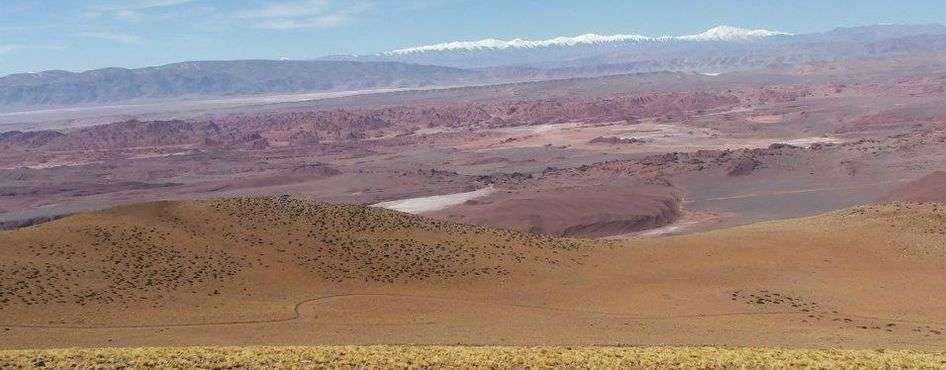
The New Astronomical Complex
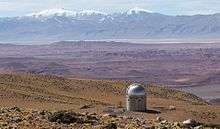
The IATE is building an astronomical complex on the Cordón Macón, located at 10 km from the town of Tolar Grande, Salta, Argentina. The site is located at latitude 24.61 South and longitude 67.32 West and at an altitude of 4,650 meters. The location has ideal conditions of humidity and air turbulence, which create almost perfect astronomical seeing. The site infrastructure will enable the development of several observational projects:
- The ABRAS project: The Argentina-Brasil Astronomical Center is a project involving both Latin-American countries. The main institutions behind the project are the IATE, from Argentina, and the IAG (Instituto de Astronomia, Geofísica e Ciencias Atmosféricas), from Sao Paulo, Brasil, while the funding institutions are the Ministerio de Ciencia, Tecnología e Innovación Productiva and the University of Sao Paulo (Universidade de Sao Paulo, USP). The project involves the installation of an astronomical observational facility in the Cordón Macón. The 1 meter telescope will be installed in an 8-meter diameter dome. The building and the installation of the dome was performed during 2011-2012, while the 1 meter telescope arrived to Córdoba (Argentina) during october 2015. One of the main goals of the project is to optimize the telescope for performing astronomical observations in the infrared part of the electromagnetic spectrum. The first observations with this telescope is expected to be perform for the year 2016.
- The TOROS project: The Transient Optical Robotic Observatory of the South (TOROS) project is a collaboration among scientists from The University of Texas at Brownsville, the Universidad Nacional de Cordoba (UNC), CALTECH and Texas A&M University. The project intend to construct a dedicated optical follow-up instrument for Advanced LIGO (aLIGO) and Advanced Virgo (AdVirgo) in order to surveying the sky for even very dim afterglows of gravitational waves events. The project also pursuit the aim of detecting nearby supernovas. The first workshop of the TOROS collaboration was held in the city of Salta, Argentina, in June, 2013.
- The ISON project: The International Scientific Optical Network (ISON) program is an international effort that intend to understand and catalogue the space debris population in the near-Earth space and of potentially hazardous Near Earth Objects (NEOs). In order to contribute to this program, the Keldysh Institute of Applied Mathematics (KIAM) of the Russian Academy of Sciences (RAS), of the Russian Federation, will work together with the Comisión Nacional de Actividades Espaciales (CONAE), the IATE, the Observatorio Astronómico de Córdoba (OAC) and the Goberment of the Provincia de Salta in Argentina, to install and operate two small telescopes of 20 and 25 cm of diameter, that will be operated remotely via Internet connection. The aim of this cooperation is to perform observations of orbital debris, asteroids, comets and optical counterparts of gamma-ray bursts.
FoF meetings
Yearly, the IATE organizes the astronomical meeting named "Friends-of-Friends", usually carried out during the first fortnight of April. The meeting is aimed at stretching the bounds between the astronomers that work at the IATE and their external collaborators, as well as sharing the state-of-the-art of works that are being developed by the IATE members. The talks are split into two different modes: invited speakers present talks of 45+15 minutes, while there are several short talks of 15+5 minutes long.
| Year | Invited speakers | Affiliation | Title |
|---|---|---|---|
| 2011 | Gary Mamon | IAP, Paris, France | How do galaxies acquire their mass and when do they form their stars? |
| Juan Madrid | CAS, SUT, Melbourne, Australia | Structural parameters of globular clusters and UCDs in Virgo and Coma | |
| Norbert Przybilla | AI, FAU, Erlangen, Germany | Galactochemical evolution as traced by massive stars | |
| Dante Minniti | PUC, Santiago, Chile | Charting the hidden side of the Milky Way | |
| Gian Luigi Granato | INAF, Padova, Italy | Puffing up early-type galaxies by baryonic mass loss: Numerical Experiments | |
| Osvaldo Moreschi | FAMAF-UNC, Córdoba, Argentina | Gravitational lensing in terms of Energy-Momentum tensor and an interesting solution of Einstein equation | |
| 2012 | Nelson Padilla | PUC, Santiago, Chile | Megaparsec scale effects on the inner pcs of galaxies |
| Lucas Macri | TAMU, Texas, EE.UU. | The Cepheid Distance Scale in the era of precision cosmology | |
| Dante Minniti | PUC, Santiago, Chile | New Southern Extrasolar Planet Searches | |
| Carlos Briozzo | FAMAF-UNC, Córdoba, Argentina | Empirical mode decomposition: a new tool for signal analisys | |
| Robert Proctor | IAG, Sao Paulo, Brazil | JPAS: a new resource for stellar population research? | |
| 2013 | Daniel Gómez | IAFE, UBA, Buenos Aires, Arg. | Magnetic fields in astrophysics: the dynamic of the solar corona |
| Dante Minniti | PUC, Santiago, Chile | The Milky Way galaxy | |
| Christian Moni-Bidin | IAUCN, Antofagasta, Chile | Dynamical mass in the solar neighborhood | |
| Mario Díaz | UTB, Brownsville, EE.UU. | The TOROS project and the advanced LIGO era | |
| Sofía Cora | FCAG, UNLP, La Plata, Arg. | Galaxy formation: what can we learn from semi-analytic models? | |
| Federico Stasyszyn | USM, Munich, Germany | Insights on magnetic fields in astrophysics | |
| Facundo Gómez | UM, Ann Arbor, EE.UU. | Examining galaxy formation and evolution with the Milky Way and its satellites | |
| Nelson Padilla | PUC, Santiago, Chile | Effects of the stochasticity of galaxy angular momentum growth on star formation | |
| Alessio Romeo | UAB, Santiago, Chile | Evolution of the metallicity-mass relations from cosmological-SPH simulations of galaxy clusters and groups | |
| Osvaldo Moreschi | FAMAF-UNC, Córdoba, Argentina | Modeling compact objects by particles in general relativity | |
| Ezequiel Treister | UC, Concepción, Chile | The cosmic history of black hole growth | |
| Patricia Tissera | IAFE, UBA, Buenos Aires, Arg. | The stellar haloes of Milky-Way galaxies:chemical patterns and their history of assemble | |
| 2014 | Osvaldo Moreschi | FAMAF-UNC, Córdoba, Argentina | Exact solutions with spheroidal geometries and it use in astrophysical systems |
| Nelson Padilla | PUC, Santiago, Chile | Effects of spin flips and siews on galaxy formation | |
| Douglas Geisler | UC, Concepción, Chile | What is a globular cluster? What is an open cluster? | |
| Cesar Bertucci | IAFE, UBA, Buenos Aires, Arg. | Induced magnetospheres in the Solar System | |
| Pablo Dmitruk | DF-UBA, Buenos Aires, Arg. | Low frequency fluctuations and magnetic field reversals in MHD turbulence | |
| Lilia Bassino | FCAG, UNLP, La Plata, Arg. | Stellar systems in the Antlia Cluster | |
| Daniel Carpintero | FCAG, UNLP, La Plata, Arg. | Tori, chaos, resonances: a new way of looking at orbits | |
| Juan Carlos Forte | FCAG, UNLP, La Plata, Arg. | Globular clusters: the ADN of early type galaxies? | |
| Sergio Elaskar | FCEFyN-UNC, Córdoba, Arg. | New theory for chaotic intermittency | |
| Paul Matthew Sutter | IAP, Paris, France | Cosmic voids as cosmological laboratories | |
| Rory Smith | UC, Concepción, Chile | The effects of ram pressure and harassment on dwarf galaxies | |
| 2015 | Mario Díaz | UTB, Brownsville, EE.UU. | Looking for the first kilonova |
| Osvaldo Moreschi | FAMAF-UNC, Córdoba, Argentina | General equations for gravitational lenses in cosmology | |
| Dante Minniti | PUC, Santiago, Chile | Galactic structure with the VVV Survey | |
| Omar López Cruz | INAOE, México | Seyfert's Sextet: Timing the Disruption of Galaxies and the Formation of the Intragroup Medium | |
| Georgina Coldwell | UNSJ, San Juan, Argentina | On the relation between AGN and environment at low redshift | |
| Sergio Cellone | FCAG, UNLP, La Plata, Arg. | Optical studies of AGN, their host galaxies, and their environments | |
| Noam Liberskind | AIP, Potsdam, Germany | Shearing and shaping the dwarf galaxies of the Local Group | |
| Gian Luigi Granato | INAF, Padova, Italy | The early phases of galaxy clusters formation in IR | |
| Cristina Mandrini | IAFE, UBA, Buenos Aires, Arg. | Solar coronal magnetic field structure and observed energy release locations | |
| Daniel Gomez | IAFE, UBA, Buenos Aires, Arg. | Reconexión magnética y turbulencia en plasmas espaciales y astrofísicos | |
| Carlos Carrasco | CRYA, México | Radio emission from Protostellar Jets | |
| Mario Daniel Melita | IAFE, UBA, Buenos Aires, Arg. | The colors of the objects in the outer Solar System: cosmic radiation, activity and physical collisions | |
| Carlos Colazo | OAC, Córdoba, Argentina | Discovery of the first ring system in an asteroid | |
| Nelson Padilla | PUC, Santiago, Chile | Robust estimators for correlation function measurement | |
| Lucas Macri | TAMU, Texas, EE.UU. | The Hubble constant in the era of precision cosmology | |
| Stefan Gottloeber | AIP, Potsdam, Germany | Cosmology with the Jubilee and MultiDark simulations | |
| Claudia Mendes de Oliveira | IAG, Sao Paulo, Brazil | Environmental studies of galaxies with A-PLUS and J-PAS | |
| 2016 | Sofía Cora | FCAG, UNLP, La Plata, Arg. | Evolution of galaxy properties: metallicity and colors |
| Georgina Coldwell | UNSJ, San Juan, Argentina | Systematic search of extragalactic sources in the VVV survey area | |
| Stefano Cristiani | INAF, Padova, Italy | The contribution of quasars and galaxies to the UV background | |
| Giuseppe Murante | INAF, Padova, Italy | Simulating disk galaxies with a novel sub-grid prescription | |
| Gian Luigi Granato | INAF, Padova, Italy | The central structure of intra-cluster medium: recent encouraging results from simulations | |
| Laerte Sodré | IAG, Sao Paulo, Brazil | Galaxy evolution with machine learning | |
| Rosa Domínguez Tenreiro | UAM, Madrid, Spain | Some inputs on galaxy formation and its observational consequences | |
| Lilia Bassino | FCAG, UNLP, La Plata, Arg. | What can non-standard properties of globular cluster systems tell us on its host-galaxy formation? | |
| María Fernanda Nievas | University of Innsbruck, Austria | OB stars as laboratories for numerous astrophysical fields | |
| Omar López Cruz | INAOE, México | SCI-HI: Searching for the first galaxies | |
| Mario Díaz | UTB, Brownsville, EE.UU. | The birth of gravitational wave astronomy | |
| Arianna Di Cintio | DCC, Copenhagen, Denmark | Distinguishing CDM from non standard DM models: the vital role of baryon physics | |
| Lucas Macri | TAMU, Texas, EE.UU. | Extragalactic variables and their application to cosmology | |
| Sergio Dasso | IAFE, UBA, Buenos Aires, Arg. | Coherent and LSSs in the solar wind, their driven shocks, and effects on galactic cosmic rays | |
| Mario Melita | IAFE, UBA, Buenos Aires, Arg. | The origin of the ring system of asteroid (10199) Chariklo | |
| Octavio Guilera | FCAG, UNLP, La Plata, Arg. | Numerical methods in giant planet formation | |
| Gustavo Romero | IAR, Buenos Aires, Argentina | Gravitational waves: history, detection, and prospects | |
| Edition | Year | LOC Members |
|---|---|---|
| I | 2011 | Eugenia Díaz-Giménez, Cinthia Ragone Figueroa, Ariel Zandivarez, José Nilo Castellón, Heliana Luparello, Viviana Bertazzi, Diego García Lambas |
| II | 2012 | Marcela Pacheco, Andrés Ruiz, Ernesto Zurbriggen, José Nilo Castellón, Dario Graña, Viviana Bertazzi, Eugenia Díaz-Giménez, Diego García Lambas |
| III | 2013 | Mario Sgró, Ismael Ferrero, Diego García Lambas |
| IV | 2014 | David Algorry, Ernesto Zurbriggen, Andrea Costa, Diego García Lambas |
| V | 2015 | Facundo Rodriguez, Adriana Rodriguez Kamenetzky, Elizabeth Gonzalez, Andrea Costa, Diego García Lambas |
| VI | 2016 | Mario Abadi, Valeria Coenda, Gian Luigi Granato, Julián Martinez, Cinthia Ragone Figueroa, Viviana Bertazzi, Andrea Costa, Diego García Lambas |
-

Poster of the 1st FoF meeting (2011)
-

Poster of the 2nd FoF meeting (2012)
-

Poster of the 3rd FoF meeting (2013)
External links
- (Spanish) Official Site of IATE.
- (Spanish) Observatorio Astronómico de Córdoba (OAC)
- (Spanish) Universidad Nacional de Córdoba
- (Spanish) Consejo Nacional de Investigaciones Científicas y Técnicas (CONICET)
- (Spanish) Ministerio de Ciencia, Tecnología e Innovación Productiva
- (Spanish) Comisión Nacional de Actividades Espaciales (CONAE)
- I FoF Meeting (2011)
- II FoF Meeting (2012)
- III FoF Meeting (2013)
- IV FoF Meeting (2014)
- V FoF Meeting (2015)
- VI FoF Meeting (2016)
- Workshop José Luis Sérsic (2013)
- TOROS Official Site
- First TOROS Workshop: Gravitational Wave and Optical Astronomy in the Southern Cone
- Keldysh Institute of Applied Mathematics
References
- ↑ http://www.fundacionkonex.com.ar/b1038-l-Jose%20Luis-Sersic
- ↑ http://www.iate.oac.uncor.edu/miembros
- ↑ http://www.unc.edu.ar/seccion/novedades/2008/mayo/cientificos-de-la-unc-estudian-la-puna-saltena
- ↑ http://archivo.lavoz.com.ar/08/05/09/secciones/sociedad/nota.asp?nota_id=188054
- ↑ https://www.youtube.com/watch?v=KSJeKmqsmYs
- ↑ https://www.youtube.com/watch?v=dlmHTEC8CGQ
- ↑ https://www.youtube.com/watch?v=SeJ9m6vPRc4
- ↑ http://www.hoylauniversidad.unc.edu.ar/2012/junio/argentina-tendra-su-cuarto-observatorio
- ↑ http://astronomiadecordoba.blogspot.com.ar/2010/08/el-instituto-de-astronomia-teorica-y.html
- ↑ http://www.secyt.unc.edu.ar/unc/boletin_contenido.php?idNota=271